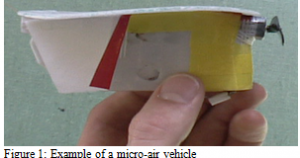Andrew Hosford and Dr. Deryl Synder, Mechanical Engineering
Recently, there has been increased interest in the development of micro air vehicles (MAVs) (Figure 1) to perform reconnaissance, surveillance, and other small operations best suited for air vehicles with maximum dimensions of six inches. In order to develop successful air vehicles, it is imperative to have correct fluid flow modeling. As of late, current modeling tools used to design and analyze full-scale aircraft do not work well for MAVs[1]. This lack of appropriate tools has lead current research to take a trial and error approach to design of MAVs—a very expensive and inefficient technique.

A less costly approach to modeling this sort of flow is by using computers to approximate the flow field. One approach to this is Large Eddy Simulation (LES). Large Eddy Simulation essentially creates a mathematical model that approximates eddies in fluid flow. This approach provides an effective means for modeling the entire flow field around MAVs. Drs. Deryl Snyder and G. Degrez (of the von Karman Institutefor Fluid Dynamics, Belgium), are developing a computer program that uses LES to create the fluid-flow models needed to develop efficient MAV airfoils [2]. The program is unique in that it approaches this problem by using finite-element methods (FEMs) combined with a spectral discretization. In brief, the finite-element method is a technique that solves problems by dividing a region into small units called elements (Figure 2). Mathematical equations are solved for each element, and one can see the final result by summing up the effects of each element on its neighbors.
Despite the advantages that FEMs [3] provide in solving this problem, there is a lot of skepticism in applying it to solving turbulent fluid flow, especially LES. These concerns are primarily about the accuracy of the results and the amount of time it takes to perform these calculations. Therefore, the results of this solver were compared with accepted data published by Kravchenko and Moin which demonstrated fluid flow around a cylinder under laminar (Re 300) and turbulent conditions (Re 3900). It was decided to use the LES solver for these two cases.

To begin solving, a grid needed to be created to model flow around the cylinder. Since the accuracy of the results was dependant on the number of elements solved by the program, it was decided to show that a finer grid (a grid with more elements) provided more accurate data. As a result, two grids were created–one was a coarse grid and the other was a fine grid (Figure 2). The fluid entered from the left side and flowed over the cylinder in the center exiting to right of the grid. The solver then extended the problem into 3-D space. Since I was more interested in what happened downstream of the cylinder, I created a higher density of elements just around and downstream of the cylinder. Since each element requires computational time, this allowed the computer to spend more time computing in the area I was interested in.
The results were satisfying (Figure 3). They showed that the LES solver satisfactorily modeled fluid flow around a cylinder. Of the 15 different velocity profiles that were compared with data from Kravchenko for Re 300, only 1 case did not match. For the Re 3900 case, all 9 of the velocity profiles matched up with the data from Kravchenko and Moin. The fine grid created slightly better results, as expected.

The one case that did not match up with the data differed only in the region just behind the wake (x=1.2D) for Re 300. This deviation in computation was attributed to the convective stabilization terms which use averaging techniques to approximate an increase in viscosity within an element. This practice was intentionally done since averaging techniques require less computation time than direct calculation of the convective stabilization terms. It is proposed that further study be performed to remedy this inaccuracy.
The research was not without its frustrations. Because of the heavy calculations involved, all the data was computed on BYU’s supercomputer—marylou4. However, even with supercomputing power, some of the cases took up to 5 days to complete. In several instances, there were problems on the supercomputer and the calculations would have to start all over again.
Overall the discrepancies were minor; therefore, the results were deemed acceptable approximations of fluid flow over a cylinder—thus validating the LES solver.
Sources
- Mueller, T. J. and J. D. Delaurier. “Aerodynamics of Small Vehicles,” Annual Review of Fluid Mechanics 35 (2003): 89-111.
- Snyder, D.O. and Degrez, G., “Large-Eddy Simulation with Complex 2-D Geometries Using a Parallel Finite-Element/Spectral Algorithm,” International Journal for Numerical Methods in Fluids vol. 41 no. 10 (2003): 1119–1135.
- Gresho, M. and Sani, R. L., Incompressible Flow and the Finite Element Method, vol 1, Avection-Diffusion. New York: John Wiley and Sons, LTD, 1998.
